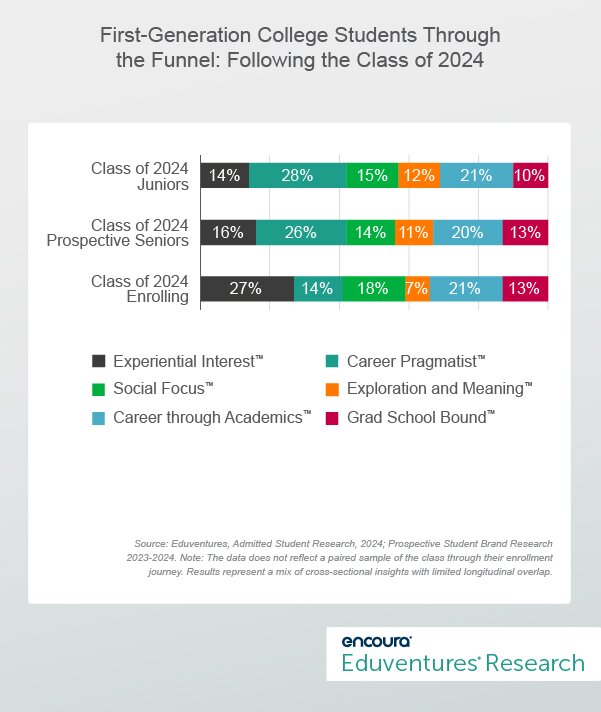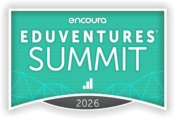Last fall, the Common Application reported a 14% year-over-year increase in first-year applications among first-generation college students—a substantial increase that outpaced the overall average. And when these students step on campus soon, they will find themselves in good company: 54% of all undergraduates now identify as first-generation college students (according to FirstGen Forward).
This means that understanding first-generation students and supporting them through the student lifecycle has never been more essential. Eduventures Research finds that while core interests of this group stay consistent across the enrollment funnel, notable changes arise between the inquiry and decision stages—offering insights that can sharpen your recruitment efforts.
Nearly all high school students engaged in college search experience evolving perspectives as they integrate new information, experiences, and feedback along the way. Let’s follow the class of 2024 to understand how first-generation student perspectives changed throughout the enrollment funnel. The Eduventures Student Mindsets™ (Mindsets) provide a good shorthand, allowing us to go beyond demographics, illuminating the motivations and considerations behind student decision-making.
Figure 1 shows the Mindsets distribution for the class of 2024 at three poignant moments: junior year, senior year, and final enrollment.

Figure 1.
Starting at Search
Figure 1 indicates that Student Mindsets remain relatively stable from junior to senior year among first-generation students. This stability offers admissions and marketing teams an opportunity to deepen engagement and maintain a consistent messaging strategy.
Notably, at this phase, first-generation students have a greater proportion of the Career Pragmatist Mindset—known for sensitivity to affordability and focus on immediate return on investment. Another strong proportion is the Career through Academics Mindset—students who see academics as the path to long-term career goals. Student stories highlighting recent alumni success, practical career pathways, and transparent cost navigation resonate at this stage.
Moving Toward the Enrollment Finish Line
Figure 1 also shows that the Mindsets begin to shift as students make their college choices. The transition from senior inquiry to final college choice shows a pronounced drop in Career Pragmatist students and a rise in Experiential Interest students.
Experiential Interest students are closely related to Career Pragmatist students with a focus on career outcomes and affordability. Where they are distinct is in their motivations for hands-on learning and immersive experiences that will prepare them for life after college.
So, why such a dramatic shift in Mindsets from inquiry to enrollment? Below are some clues:
- There is a steep increase in students wanting to make lasting friendships (nine percentage points).
- We also see increases in students interested in learning experiences centered around interactions with faculty and participation in student clubs.
- At the exploration phase, first-generation students want to understand the diversity of academics and career preparation. While these items are still important at the decision phase, academic strength and the campus environment play a larger role.
What explains these shifts? As first-generation college students settle into their college choices, they explore more about the college experience—and they become excited about it.
Mindset shifts can also be attributed to cumulative college search efforts—exploring websites, engaging with social channels, and connecting with admissions teams. While still sensitive to price and career opportunities, they now see the college experience itself as a key to their goals.
Another thought to bear in mind is that these changes could also signal shifts in the make-up of the college pipeline itself. Career Pragmatist students are cost-sensitive and looking for more immediate results—their sharp decline at the point of enrollment commitment could reflect an exit from the college pipeline. This possibility encourages strengthened yield messaging to admitted first-generation college students.
Areas of Consistency Across the Funnel
While we have focused on areas where Mindsets shift among first-generation prospective students thus far, Figure 1 also shows which areas remain remarkably consistent across the funnel. What holds true for these students throughout the enrollment journey?
- Career preparation. Nearly half of first-generation students, regardless of funnel status, are eager to engage with work-study. Over two-thirds of students want internships. Highlighting pathways to skill-building and resume development meets these interests head on.
- Affordability. As the leading decision driver, it is hard to overstate the importance of affordability for first-generation students across the entire enrollment funnel. Clear, student-centered messaging is key, from first contact through enrollment.
- Belonging. Many first-generation college students also identify as low-income students and/or from underserved populations. Helping first-generation students find community and belonging is key during the enrollment journey.
The Bottom Line
The rise in first-generation applicants calls for reflection on their needs as they move through the enrollment funnel. Admissions teams will be wise to adapt messaging to reflect both the stable priorities and evolving aspirations of first-generation college students. As the first in their families to choose college, higher touch connections can make a real impact on their persistence through the pipeline.
But support can’t stop at enrollment. Mindsets can also be a powerful tool as students discover emerging needs once on campus. Colleges have room to grow in retaining and graduating first-generation college students—and the time from commitment to enrollment is a prime opportunity to share student success resources.
Enrollment teams that tailor their messaging not only for the purpose of recruitment, but also to prepare and empower students, strategically position themselves to effectively engage with first-generation college students before and after they step onto campus.

